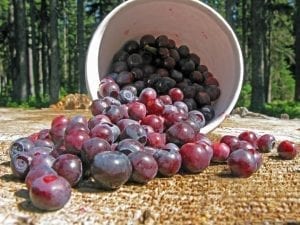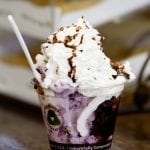When the late summer heat arrives in West Yellowstone, locals and visitors alike trek through the wilderness in search of a regional treat—the huckleberry. Bursting with a unique flavor that’s both sweet and tart, huckleberries are a seasonal delight in Greater Yellowstone for those willing to venture off the beaten path and explore the surrounding mountains. Whether you’re interested in hunting for huckleberries or simply stocking up on some huckleberry-flavored goodies, West Yellowstone is your destination for a one-of-a-kind huckleberry adventure.
What is a huckleberry?

Gathered huckleberries. (Dreamstime images)
Huckleberries are a type of wild berry unique to areas of the Rocky Mountains and the Pacific Northwest. The berries range from a deep red to a dark blue or purple color. Huckleberries are related to both blueberries and cranberries and offer a singular sweetness paired with a subtle tartness that gives them a truly distinct flavor. Besides their delicious taste, the berries boast a number of health benefits and are loaded with antioxidants, iron, vitamin C, and potassium. Wild huckleberries are also free from the chemicals, pesticides, and fertilizers often used in commercial growing operations.
Huckleberries grow on huckleberry bushes—small, shrub-like, evergreen plants that thrive in the underbrush of Greater Yellowstone’s subalpine forests. Though the bushes flourish in the wild, scientists haven’t had much success with domesticating the plants. As a result, huckleberry enthusiasts must scour the surrounding forests each year to locate the bushes and harvest the berries.
Finding huckleberries
Huckleberry hunters in Greater Yellowstone begin keeping an eye out for huckleberries in late July. The season generally continues through August and can even run as late as September during cold, rainy years.
Greater Yellowstone’s high-elevation forests, populated with a variety of pine and fir trees, offer the perfect habitat for huckleberry bushes to prosper. Huckleberry bushes can range in height from a couple of inches to a few feet tall. The plants grow in both sunny and shady forested areas. They also grow abundantly in the forests’ older burn areas and can flourish in sunlit clearings created by logging, avalanches, or ski activity.
Novice huckleberry hunters can easily confuse the huckleberry with the serviceberry (or June berry)—another wild berry that’s reddish in color but lacks the flavor of huckleberries. Serviceberry plants tend to grow slightly taller than huckleberry bushes and the red berries have a less glossy appearance. Properly identifying a huckleberry bush can take practice, but it’s well worth the effort when you return with a bounty of delicious huckleberries!
Picking tips
Besides being a favorite treat for locals and visitors, huckleberries are also a favorite snack for wildlife, especially black and grizzly bears. The high sugar content of the berries helps the bears store fat for the winter. In fact, huckleberries can comprise up to one-third of a grizzly bear’s diet in the late summer and early fall. For this reason, huckleberry hunters should avoid picking huckleberries around dawn and dusk when bears are most active.
The late-summer huckleberry harvest also coincides with an influx of mosquitos, deer flies, and horse flies in Greater Yellowstone. Huckleberry hunters should wear protective clothing and use plenty of insect repellant when venturing into the wild to avoid painful and irritating bites.
For an optimal huckleberry-picking experience, consider bringing a storage container to hold the berries, plenty of water, bear spray, insect repellent, and a map.
What to do with huckleberries

Huckleberry Ice Cream Sundae at Eagle’s Historic Soda Fountain
Huckleberries need to be frozen, dried, or consumed soon after they are harvested. Otherwise, the juicy berries begin to ferment and clump together. Place berries in a strainer and carefully remove any sticks, leaves, or bugs. If you freeze the berries, remove excess moisture and place them in a freezer-safe container or ziplock bag.
Huckleberries are a delicious snack on their own or they can feature in countless sweet and savory recipes. Most blueberry recipes generally adapt well to huckleberries. Try baking fresh or frozen huckleberries in pies, tarts, cobblers, or pancakes for a unique Montana treat!
Local huckleberry treats
Not enough time to pick them yourself? Local shops in West Yellowstone and Yellowstone National Park offer a variety of edible huckleberry goodies as well as huckleberry-flavored items ranging from lip balm to bath salts. Below is a partial list of local

Huckleberry Lemonade at Buffalo Bar
huckleberry treats visitors can enjoy:
- Huckleberry margaritas at the historic Old Faithful Inn
- Huckleberry ice cream at Mammoth Hot Springs
- Huckleberry shakes at Eagle’s Store
- Huckleberry cheesecake and huckleberry bread pudding at Bullwinkle’s
- Sweet cream pancakes with local huckleberries at Three Bear Restaurant
- Huckleberry lemonade at Buffalo Bar & Casino
- Huckleberry burgers at Madison Crossing
Whether you choose to venture into the forest on a huckleberry-picking expedition or stay close to town and enjoy the local
huckleberry treats, be sure to include huckleberries as an essential part of your next West Yellowstone vacation.
AUTHOR: CAITLIN STYRSKY